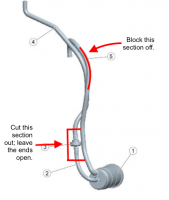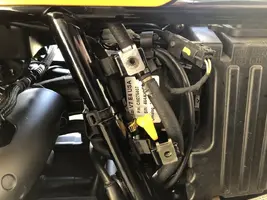I took some pictures while working on disabling the evap can yesterday. Hopefully this will help someone out there... :
Illustrated Procedure:
- remove seat
- remove left side panel (three bolts)
- remove starter cover (two bolts)
- locate vacuum tap line from manifold to canister under the gearbox
View attachment 13677
- cut vacuum line and block it (I glued an aluminum slug in place)
Follow the line and cut it in a convenient place, then block it ... particularly the upstream side that comes from the inlet manifold.
View attachment 13678
- locate breather line with valve connected to canister
- cut breather line above the valve and below at the canister inlet
View attachment 13679
View attachment 13680
- leave the breather line open ended behind the starter ... put a filter on it if you worry about environmental dust getting into the tank (but it ain't going to happen...

- replace starter cover
- replace side cover
- replace seat
Hope that's clear ... ask if you have any questions.













